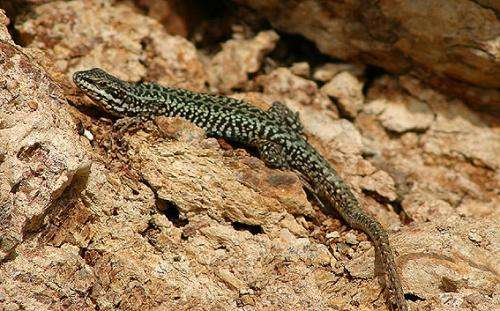June 18, 2014 report
Study shows impact of feral cats on lizards in Greek Islands

A team of researchers with diverse backgrounds from universities in the U.S. and Greece has conducted a study of the impact of feral cats on Aegean wall lizards living in the Cyclades (Greek islands). In their paper published in Proceedings of the Royal Society B: Biological Sciences, the team describes behavior adaptations they observed in native lizards to the presence of feral cats.
Feral cats are domestic cats that are living in the wild—reports over the past several years have implicated them in a number of extinctions and declines of other species, particularly birds. Another type of creature impacted by feral cats is lizards—cats are known to kill them whether they eat them or not. In this new study, the research team ventured to the Thera, Kea and Naxos islands in the Cyclades—where cats were introduced by humans approximately 9,500 years ago—to learn more about how the native lizards have adapted to the introduced threat.
The goal of the study was to document both the population of the lizards in areas where the cats lived and adaptive behaviors that have come about to help them survive. To determine populations, the researchers counted how many lizards they spotted during various outings. Adaptive behaviors were noted by placing cat decoys in areas where the lizards lived and comparing behavior observed in areas where there were more, less or no cats at all.
The researchers found that in areas where cats were plentiful, lizard populations were approximately half those of areas where there were no cats at all (nearby islets). They noted also that lizards that faced a greater threat from cats tended to keep close to refuge areas and also tended to resort to tail shedding more often. The team also noted that the lizards tended to flee sooner upon sighting the researchers in areas of greater threat. Perhaps most interesting, the team found a great degree of plasticity in adaptation to cat risk—flight initiation distance was directly related to the number of cats in an area. On the islets, where cats have never been, the lizards showed virtually no fear of decoy cats and even approached them on several occasions.
Overall the study shows how the introduction of an exotic species can have a dramatic impact on island species and how some species adapt long term to the introduction of one such predator, the feral cat.
More information: Effects of feral cats on the evolution of anti-predator behaviours in island reptiles: insights from an ancient introduction, Proceedings of the Royal Society B, Published 18 June 2014 DOI: 10.1098/rspb.2014.0339
Abstract
Exotic predators have driven the extinction of many island species. We examined impacts of feral cats on the abundance and anti-predator behaviours of Aegean wall lizards in the Cyclades (Greece), where cats were introduced thousands of years ago. We compared populations with high and low cat density on Naxos Island and populations on surrounding islets with no cats. Cats reduced wall lizard populations by half. Lizards facing greater risk from cats stayed closer to refuges, were more likely to shed their tails in a standardized assay, and fled at greater distances when approached by either a person in the field or a mounted cat decoy in the laboratory. All populations showed phenotypic plasticity in flight initiation distance, suggesting that this feature is ancient and could have helped wall lizards survive the initial introduction of cats to the region. Lizards from islets sought shelter less frequently and often initially approached the cat decoy. These differences reflect changes since islet isolation and could render islet lizards strongly susceptible to cat predation.
Journal information: Proceedings of the Royal Society B
© 2014 Phys.org

















